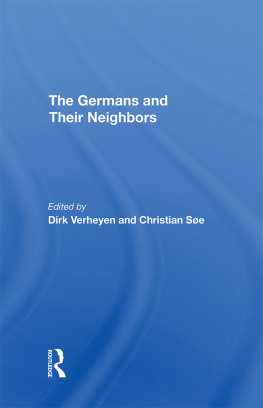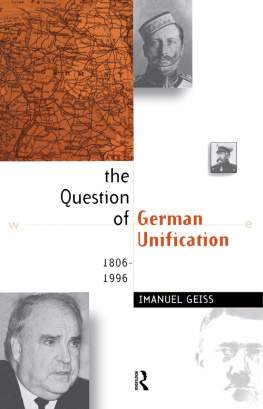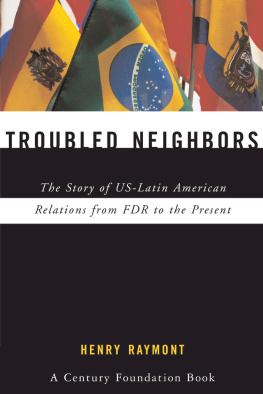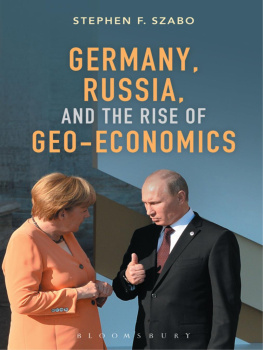The Germans and Their Neighbors
The Germans and Their Neighbors
Edited By
Dirk Verheyen and Christian Se
First published 1993 by Westview Press, Inc.
Published 2019 by Routledge
52 Vanderbilt Avenue, New York, NY 10017
2 Park Square, Milton Park, Abingdon, Oxon OX14 4RN
Routledge is an imprint of the Taylor & Francis Group, an informa business
Copyright 1993 Taylor & Francis
All rights reserved. No part of this book may be reprinted or reproduced or utilised in any form or by any electronic, mechanical, or other means, now known or hereafter invented, including photocopying and recording, or in any information storage or retrieval system, without permission in writing from the publishers.
Notice:
Product or corporate names may be trademarks or registered trademarks, and are used only for identification and explanation without intent to infringe.
Library of Congress Cataloging-in-Publication Data
The Germans and their neighbors / edited by Dirk Verheyen and
Christian Se.
p. cm.
Includes bibliographical references.
ISBN 0-8133-8522-9 (hc) ISBN 0-8133-1959-5(pbk.)
1. GermanyForeign relations1990 .I. Verheyen, Dirk.
II. Se, Christian.
DD290.3.G47 1993
327.43 dc20 91-38102
CIP
ISBN 13: 978-0-367-29255-3 (hbk)
Contents
, Dirk Verheyen and Christian Se
, Anne-Marie LeGloannec
, Anthony Glees
, Dirk Verheyen
, John Fitzmaurice
Christian Se
, Trond Gilberg and Jens Drews
, Steven S. Koblik
, Alpo Rusi
, F. Stephen Larrabee
Arthur R. Rachwald
, Milan Hauner
, Ivan Volgyes
, Robert R. King
, Sabrina Petra Ramet
, Max E. Riedlsperger
, Mark Stucki
, Gian Enrico Rusconi
, Alice Ackermann and Catherine McArdle Kelleher
Guide
We would like to thank the contributors for their enthusiastic support of this project and for making its successful completion possible. We owe a special debt of gratitude to Edna Hastings for her superb typesetting work, to Dina Ng and the Loyola Marymount University library staff for their assistance in the preparation of the manuscript, and to Susan B. Mason and Steve Frye at California State University, Long Beach, for their research assistance. We are most appreciative of the professionalism of the staff at Westview Press, particularly Amos Zubrow, Susan McEachern, Alison Auch, Jennifer Watson, and Polly Christensen. Finally, we thank Louise, Nils, and Erik Se for the good humor with which they endured our seemingly endless WestchesterLong Beach telephone conversations.
Dirk Verheyen
Christian Se

. Source: David S. Mason, Revolution in East-Central Europe: The Rise and Fall of Communism and the Cold War (Boulder: Westview Press, 1992). Reprinted by permission.
Dirk Verheyen and Christian Se
Except for the new Russia within its still mercurial geopolitical configuration, Germany has more neighbors than any other state in Europe. From its location in the northern middle of the Continent, Germany borders directly on nine countries, and there are many more slightly distant neighbors. For each of them, Germany's proximity has long been a crucial fact of life. None of them can afford to be unconcerned about what happens in this centrally placed, powerful nation. All of them have been and will continue to be affected in important ways by the socio-cultural, economic, and political dynamism of Germany. All carry some memories and perceptions of intense past relations with Germany and the Germans. And all have hopes and anxieties concerning their future relationship with an enlarged and more self-confident Germany after the recent political upheaval in Europe.
Each of the 18 essays in this volume deals with the German factor from the perspective of a single country. A reading will underscore the conclusion that there is no single or simple story to be told about the Germans and their neighbors. Instead, there are multiple stories, both unique and overlapping in their complex mixtures of factors, themes, and dynamics. On one level, there are the most "practical" concerns about territory, trade and, increasingly, travel On another level, one uncovers subtle connections between cultural sensitivity and economic dependence, traumas and traditions, memories and emotions. In no case is the bilateral relationship with Germany simple and straightforward. If there is one theme that is shared by the various essays, it consists of an underlying pattern of ambivalence, fluctuating between instrumental partnership, formal cordiality or pragmatic accomodation, and wary circumspection or even latent hostility.
In the final analysis, each country's relations with Germany and the Germans have been and continue to be unique, the product of special and distinct experiences and memories. Yet in any given period, all the countries included in this volume have had to deal, in a very basic way, with the same Germany. Even though they have all had to come to grips with their particular version of the "German Question," it is possible to detect important patterns and commonalities in the bilateral relationships. The observations that follow may assist the reader in standing back from the many individual case-studies and reflect more generally on the subject.
The "German Question" can usefully be analyzed as having four distinct yet related dimensions: (a) Germany's search for a clear national identity, (b) Germany's pursuit of national unity (both in the 19th century and after 1945), (c) the impact of Germany's power on European as well as global affairs, and (d) Germany's quest for a commensurate role in international politics and economics. Many aspects of the relations between Germany and its neighbors are linked to one or more of these four dimensions of the German Question. In turn, the attitudes and policies of Germany's neighbors have been influenced by the following factors: (a) their size and power relative to Germany; (b) their proximity to or distance from Germany; (c) their general historical experience vis-a-vis Germany (with the two world wars as often decisive criteria); (d) their cultural and/or linguistic affinity with Germany; (e) the depth of their economic interaction with, if not outright dependence on, Germany; (f) the salience of border disputes (generally the result of ethno-cultural fluidity); and (g) the presence of ethnic German minorities in their national populations.
The German search for a clear national identity has had, and probably will continue to have, profound implications for several countries that share important cultural traits with Germany. This is especially so in cases of ethnolinguistic affinity, as illustrated in the essays on Austria and Switzerland. To a lesser extent the same is true for the Netherlands and the Flemish part of Belgium. In addition, the definition of German identity has been of obvious concern to those countries that contain(ed) significant communities of ethnic Germans, such as Poland, Czechoslovakia, Romania, and Denmark. These are countries that could find themselves subjected to special German influence or demands. The brutally aggressive definition of German identity during the Third Reich had terrible consequences for many other peoples in Europe, especially Jews and Gypsies as well as many Slavs.













